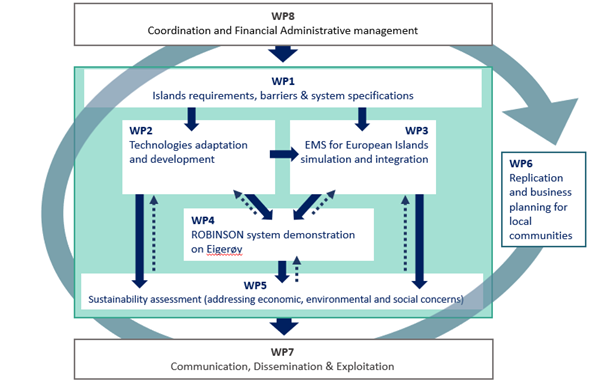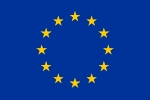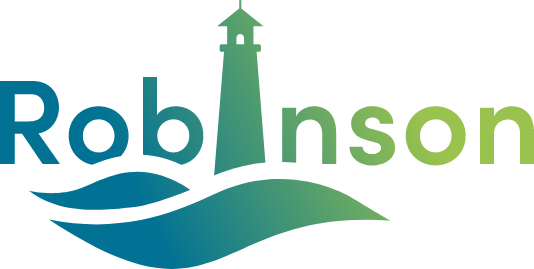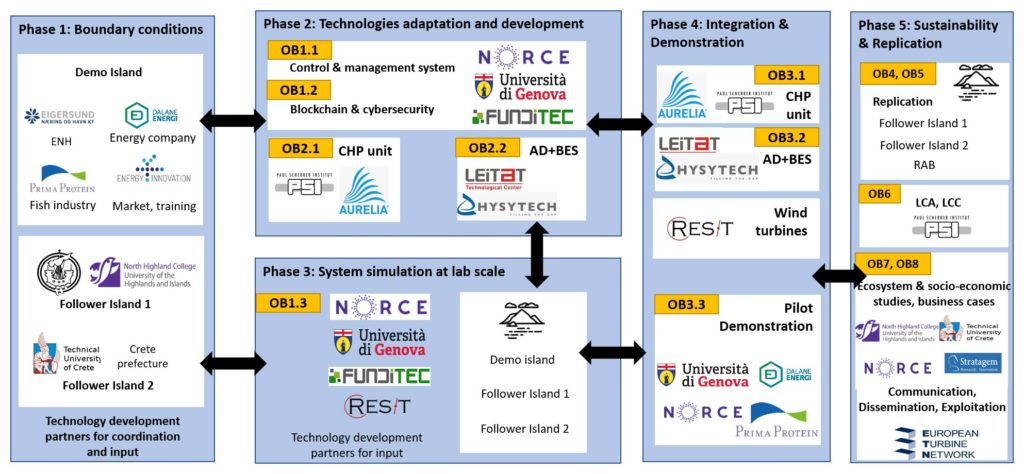
Structure
ROBINSON will last 48 months, from October 2020 till September 2024. The project is divided into five interdependent phases. Each phase is linked to specific objectives and one( or more) of the 8 interdependent Work Packages (WPs). ROBINSON’s structure increases collaboration amongst the partners and the success of the project.
Work packages

WP1’s main goal is to define the boundary conditions at the demonstration island (Eigerøy) and at the follower islands (Crete and Western Isles), to define the characteristics and interface definition of existing and new components, to optimise the overall concept and to benchmark the concept against other solutions.
WP1 starts at month 1 and ends at month 24.
Manufacturers and academia will work together in WP2 to adapt, manufacture and test different technologies (e.g. ROBINSON’s Energy Management System and related cybersecurity aspects, the innovative gas-turbine and the CHP unit, the AD+BES technology, the storage solutions, and the novel wind turbine).
WP2 starts at month 7 and ends at month 29.
WP3 will be focused on the simulation and validation of the Energy Management System (EMS). The system simulation will aim to optimised the EMS for the project’s islands and their needs to maximise the system’s performance.
WP3 starts at month 10 and ends at month 39.
WP4 will be mainly dedicated to the preparation of the necessary documentation for the pilot installation followed by the demonstration of ROBINSON on the island of Eigerøy, at Prima Protein’s industrial site.
WP4 starts at month 25 and ends at month 48.
WP5 aims to evaluate the sustainability of options for decarbonising the energy systems of geographical islands, focusing on the Demo Island and on the Follower Islands.
WP5 starts at month 1 and ends at month 48.
The main objective of WP6 is to facilitate replicability of ROBINSON concept, identify its marketability and assist business models’ transfer to other locations. Business plans for the different islands communities and replication plans are at the heart of this work package.
WP6 starts at month 1 and ends at month 48.
WP7 will focus on targeted, effective and high impact dissemination and communication activities. WP7 will contribute to the success of ROBINSON by raising awareness around the projects and its results, targeting key business, scientific and regulatory stakeholders, as well as the general public. WP7 aims also at consolidating synergies with other H2020 funded projects and EU clusters and initiatives.
WP7 starts at month 1 and ends at month 48.
WP8 deals with the coordination and management of all project activities and communication between partners, as well as between the project and the European Commission. The project will be coordinated by ETN, responsible for coordinating the overall running of the whole project, with the assistance of LEITAT (administrative and financial management), and NORCE [scientific & technical coordination and Management and Scientific Committees (MC & SC)].
WP8 starts at month 1 and ends at month 48.
Project's phases
During the first phase, all partners will be involved in the definition of the technical specifications and requirements of the ROBINSON system. Mapping of the islands specificities and their existing energy system, of possible regulatory, environmental, and safety restrictions, as well as a preliminary techno-economic analysis are performed.
Phase 2 will mark the adjustment and optimisation of the technological components of the ROBINSON system (CHP unit, AD+BES system and the wind turbine). The components will be tailored to fit into the energy system and manufactured for the demonstration. Moreover, the gas turbine, the syngas and hydrogen production, and the AD+BES system will be enhanced to best suit operation within Eigerøy overall energy system.
Phase 3 foresees the lab-scale simulation of the energy system. The EMS will be tested considering a cyber-physical approach : the system features real devices and real-time dynamic models. The concept will be validated by laboratory testing, with a real case database by using data provided by on-site measurements (such energy consumption profiles) for all three islands.
The ROBINSON pilot system managed by the validated EMS will be integrated and demonstrated on the Eigerøy island reaching TRL 7. The KPIs as set in the beginning of the project will be assessed for a successful final validation of the technology making it ready for further upscaling.
The fifth phase will consider transversal aspects essential for a successful demonstration on the islands, such as business modelling, the geographical and environmental situation, the regulatory aspects, the social acceptance and local communities involvement, and the system cost-competitiveness. A techno-economic and LCA analysis, together with an active involvement of Follower islands and wide dissemination will facilitate the replicability. Impacts on local ecosystems will be evaluated in parallel.
 This project has received funding from the European Union’s Horizon 2020 research and innovation programme under grant agreement N° 957752.
This project has received funding from the European Union’s Horizon 2020 research and innovation programme under grant agreement N° 957752. 
